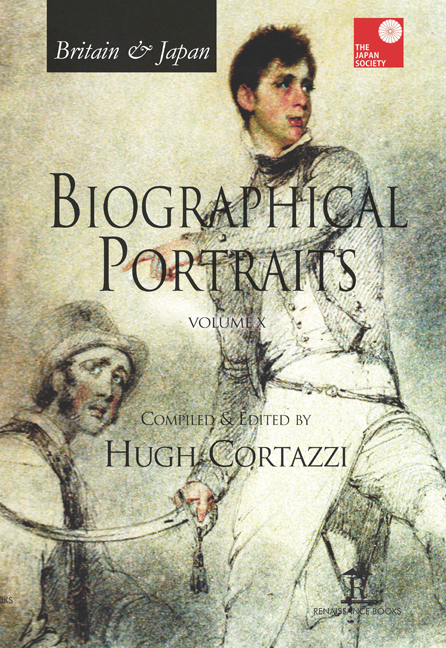Book contents
- Frontmatter
- Dedication
- Contents
- Introduction
- List of Contributors
- Index of Biographical Portraits in Japan Society Volumes
- PART I BRITAIN IN JAPAN
- PART II JAPAN IN BRITAIN
- Select Bibliography of Works in English on Anglo-Japanese Relations [Compiled by Gill Goddard – Retired East Asian Studies Librarian, University of Sheffield]
- Select Bibliography of Works in Japanese on Anglo-Japanese Relations [Compiled by Akira Hirano, SISJAC]
- Index
47 - Victorian Novelists in Japan: Thomas Hardy, Charles Dickens, Charlotte and Emily Brontë in the Twentieth and Twenty-first Centuries
Published online by Cambridge University Press: 07 May 2022
- Frontmatter
- Dedication
- Contents
- Introduction
- List of Contributors
- Index of Biographical Portraits in Japan Society Volumes
- PART I BRITAIN IN JAPAN
- PART II JAPAN IN BRITAIN
- Select Bibliography of Works in English on Anglo-Japanese Relations [Compiled by Gill Goddard – Retired East Asian Studies Librarian, University of Sheffield]
- Select Bibliography of Works in Japanese on Anglo-Japanese Relations [Compiled by Akira Hirano, SISJAC]
- Index
Summary
SINCE THE MEIJI era (1868–1912) many Japanese have been interested in the Victorian age (1837–1901). This interest continues today. There have been many academic works about the social history, culture, and literature of the age. The Victorian Studies Society of Japan, founded in 2001, has around 350 members today. Many of these are interested in Victorian literature. The 2015 membership list shows that more than 60% of the members also belong to English literary societies, most of which are related to Victorian writers. Victorian fiction has long been widely read in Japan. In the Meiji era, when Western culture became popular, novelists including Bulwer-Lytton (1803–73), William Makepeace Thackeray (1811–63), Charles Dickens (1812–70), Charlotte Brontë (1816–55), Emily Brontë (1818–48), Wilkie Collins (1824–89), Lewis Carroll (1832–98), Thomas Hardy (1840–1928), Arthur Conan Doyle (1859–1930), Rudyard Kipling (1865–1936), Robert Louis Stevenson (1850–94), and poets such as Alfred Tennyson (1809–92) and Dante Gabriel Rossetti (1828–82) were introduced to Japan. For example, the fifty volumes of Meiji Honyaku Bungaku Zenshū [The Complete Works of Literature in Translation in the Meiji Era], published by Ōzorasha in 1996–2001, contain the translations of these authors’ works published in newspapers and magazines during the Meiji era.
In the Shōwa period (1926–1989), more translations of Victorian fiction, especially novels, were produced and made English ‘classics’ more accessible to general readers. In the Meiji era the original English texts were often abridged or even adapted in Japanese versions, whereas in the 1920s and the 1930s, translations of unabridged, fulllength novels were published. For example, from 1925 to 1928, an eminent scholar of English literature, Hirata Tokuboku, produced a complete translation of Dickens’ David Copperfield. The first complete translation of Jane Eyre was published in 1930, followed by Wuthering Heights in 1932.
English literary works were often used in this period as materials for English textbooks. Erikawa Haruo, professor of Wakayama University, who has researched the history of English language education in Japan, noted that 70% of the English textbooks used in high schools under the prewar education system (equivalent to first and second year mandatory courses at postwar universities) were works by such writers as Hardy, Conan Doyle, Dickens, Shakespeare, John Galsworthy (1867–1933) and George Eliot (1819-–80). According to Professor Erikawa, Hardy and Conan Doyle were the most frequently used authors in 1930.
- Type
- Chapter
- Information
- Britain & Japan Biographical Portraits Vol X , pp. 531 - 541Publisher: Amsterdam University PressPrint publication year: 2016

